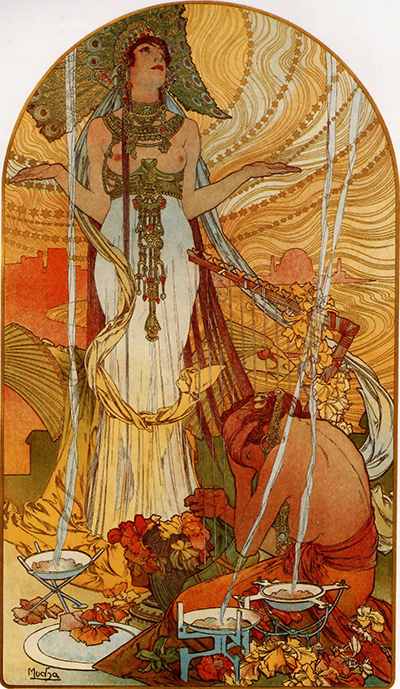Salammbô was a historical novel written by Gustave Flaubert in 1862 that provided the basis for this Alphonse Mucha painting which came about in 1896. It is now believed to be a part of a private collection and therefore rarely accessible to the public.
The piece is described as a lithograph of around 40cm in height and 20cm in width. Mucha's designs would be released as lithographic prints so that they could then be re-used which was highly necessary when producing posters to publicise various events and products. This artwork is without any of those promotional aspects, and just focuses on delivering high level of detail for both the foreground and background. We find a glamorous woman staring into the sky with her hands held open wide, and a futher figure sat on the floor with a more negative posture. They appear to be sharing a small feast which is featured alongside the two of them, and behind is a flurry of colour which completes a natural location, suggesting they have having a picnic in a rural spot. The artist makes use of a good number of different tones within his palette here, giving an impactful finish which makes Salammbo a highly memorable design.
There is certainly something of a mystical feel to this piece, as the main figure looks up to the skies, and in return various items of food come down from above, with small rope-like lengths of colour indicating this to one within this painting. The whole work feels positive, but with meanings that we can see but not quite explain without further research. Mucha would rely on literature for inspiration from time to time, and so our immediate thought heads to the novel of around three decades earlier which could not surely be a coincidence. Many other artists from around this period would do similar, with John William Waterhouse, for example, relying on poetry and novels from the 19th century to produce artworks such as Lady of Shalott, Hylas and the Nymphs and Echo and Narcissus. This type of influence spread throughout other careers within the Pre-Raphaelite movement.
It is likely that the artwork in front of us represents the very start of the novel, in which a feast is immediately presented. The two women could well be Salammbô, Hamilcar's daughter and also a freed slave by the name of Spendius. Mucha himself would produce many illustrations similar to this, some of cultural content such as this, whilst others were used to promote different products and then later dispersed as posters around the local city streets. Mucha would find himself receiving plenty of commissioned for this commercial work, but others also took advantage of this trend, including Henri de Toulouse Lautrec who completed famous pieces such as May Belfort, Ambassadeurs, Aristide Bruant and May Milton. There would also be a number of other highly skilled illustrators who also built solid careers by working in this genre, but they would not quite achieve the same level of fame as Toulouse Lautrec or Mucha and so are much less known today, often just being mentioned as a side note in discussions about these two.




